In a town as stuffed with visitor sights as Venice, it is difficult to recognize the place to begin. Perhaps the first-rate way is to clearly get misplaced for a few hours wandering via its captivating little streets and passageways, on foot beside its canals, and discovering its secret corners.
At each and every turn, you may see some thing really worth remembering with a photo. No depend the place this exploration takes you, it is effortless to discover your way again to Piazza San Marco and the Grand Canal. Most of the first-class attractions you will prefer to go to lie round these two landmarks.
Venice is divided into six sestieri, neighborhoods that have enormously special characters. San Marco is the central one, surrounded on three facets via a gorgeous loop in the Grand Canal. Across Rialto Bridge is the artisans’ regional of San Polo, and throughout the Grand Canal to the south is elegant Dorsoduro, with its prestigious artwork museums and energetic squares.
At the outer edges are Santa Croce, Castello, and Cannaregio, domestic of the unique Ghetto. Beyond the six sestieri – neighborhoods – of the metropolis itself, you will prefer to hop aboard a vaporetto to its islands: Lido, Murano, Burano, and Torcello. A fourth island, San Giorgio Maggiore, is well worth travelling for the stunning views of San Marco and Venice from the tower of its church.
To sketch your continue to be so you may not pass over any of the satisfactory locations to visit, use this listing of the pinnacle sights and matters to do in Venice.
- St. Mark’s Basilica
St. Mark’s Basilica

St. Mark’s Basilica
Certainly Venice’s best-known church, and one of the most without problems identified in the world, St. Mark’s Basilica (Basilica di San Marco) used to be initially the Doge’s personal chapel, embellished with Byzantine artwork treasures that are section of the booty introduced lower back through Venetian ships after the fall of Constantinople.
The gold-backed mosaic images above the doorways on the façade solely trace at the mosaic artistry inside, the place 4,240 rectangular meters of gold mosaics cowl the domes and walls. These set a incredibly Byzantine tone to its hovering interior, however you may locate treasures from different periods, which includes later mosaics designed through Titian and Tintoretto – names you will come across all over the city.
The marvelous golden altarpiece, the Pala d’Oro, one of the greatest in Europe, was once begun by means of early 12th-century artists, and centuries later, embellished with almost 2,000 gem stones and treasured stones. If you can tear your eyes from this, the mosaic domes, and the multitude of richly adorned altars, look down at the floor, a masterpiece of marble inlay. And take time to see the gold reliquaries and icons in the Treasury.
Read More: Exploring St. Mark’s Basilica in Venice: A Visitor’s Guide
- Piazza San Marco (St. Mark’s Square)
St. Mark’s Square
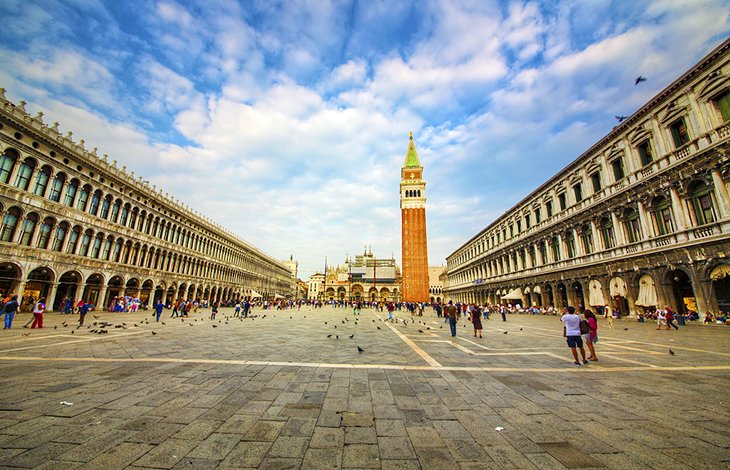
St. Mark’s Square
The sizable expanse of Venice’s greatest rectangular is added collectively and made to appear nearly intimate through the based uniformity of its structure on three sides. But greater than its architectural grace, St. Mark’s Square (Piazza San Marco) is cherished as Venice’s residing room, the vicinity every person gathers, strolls, drinks coffee, stops to chat, meets pals and tour guides, or simply passes thru on the way to work or play.
Three facets are framed in arcades, under which are stylish retail outlets and even extra elegant cafés. The open stop is bookmarked by using the erratic, extraordinary curves, swirls, mosaics, and lacy stone filigree of St. Mark’s Basilica.
Above it towers the brick shaft of the campanile. For overviews of this busy piazza, you can go to its pinnacle or to the pinnacle of the Torre dell’Orologio, the place a pair of “Moors” strikes the hour.
Read More: St. Mark’s Square, Venice: 12 Top Attractions, Tours & Nearby Hotels
- Palazzo Ducale (Doge’s Palace) and Bridge of Sighs
Palazzo Ducale (Doge’s Palace) and Bridge of Sighs
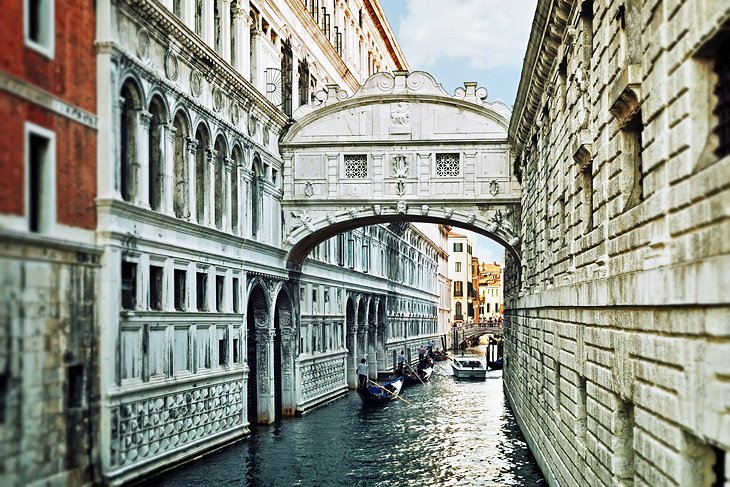
Palazzo Ducale (Doge’s Palace) and Bridge of Sighs
Visitors arriving in Venice as soon as stepped ashore below the façade of this exceptional palace. They could not have failed to be impressed, each with the aid of its measurement and the finesse of its architecture.
If they had been acquired interior via the Doges, the influence would solely beef up as they entered thru the Porta della Carta, a ideal instance of Venetian Gothic at its height, and ascended the enormous Scala dei Giganti and the gold-vaulted Scala d’Oro to be acquired in what many reflect onconsideration on to be the palace’s most lovely chamber, Sala del Collegio.
Even jaded 21st-century vacationers gasp in awe at the palace’s grandeur and lavish decoration. You’ll see works through all the Venetian greats, which includes Tintoretto, whose Paradise is the greatest oil portray in the world.
Not open on public excursions however covered on personal excursions is a stroll throughout the Bridge of Sighs to the darkish cells of the Prigioni – the prisons from which Casanova made his well-known escape. The quality view – and the postcard traditional – of the Bridge of Sighs is from the Ponte della Paglia, on the Riva degli Schiavoni in the back of the Doge’s Palace.
Lines for admission to the Doge’s Palace are regularly long, however you can keep away from these, and see sections of the palace now not open to well-known visitors, with a Skip the Line: Doge’s Palace Ticket and Tour. A neighborhood information will take you past the traces and give an explanation for the records and artwork in every of the magnificent rooms earlier than main you throughout the Bridge of Sighs and into the infamous prison.
Read More: Exploring the Doge’s Palace in Venice: A Visitor’s Guide
- Canale Grande (Grand Canal)
Canale Grande (Grand Canal)
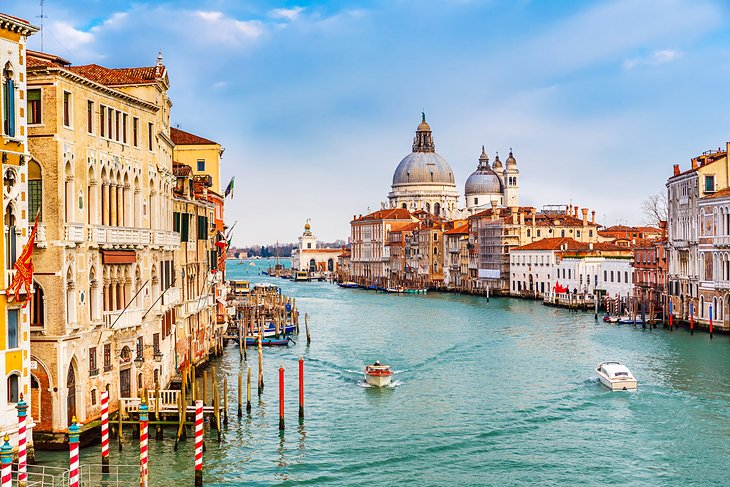
Canale Grande (Grand Canal)
Sweeping through the coronary heart of Venice in a large reverse S curve, the Grand Canal is the important boulevard via the city, connecting Piazza San Marco, Rialto Bridge, and the arrival factors of the rail station and bridge from the mainland.
Only 4 bridges pass its 3.8-kilometer length, however stripped-down gondolas known as traghetti shuttle returned and forth at a number of factors between bridges. The Grand Canal was once the address of desire for absolutely everyone who claimed any impact in Venice. Palaces of all the main households open onto the canal, their showy Venetian Gothic and Early Renaissance facades dealing with the water, via which traffic arrived.
These grand palaces – or at least their facades – are nicely preserved today, and a day trip alongside the canal with the aid of vaporetto, Venice’s floating public transport system, is the excellent way to see them. Or you can see the palaces at a extra leisurely pace on a Venice Grand Canal Small Group 1-Hour Boat Tour, which additionally consists of some of the smaller canals. And, of course, a journey alongside the Grand Canal in a gondola is one of the most romantic matters to do in Venice at night.
Read More: Exploring the Grand Canal in Venice: Top Attractions
- Ponte di Rialto (Rialto Bridge) and San Polo
Rialto Bridge
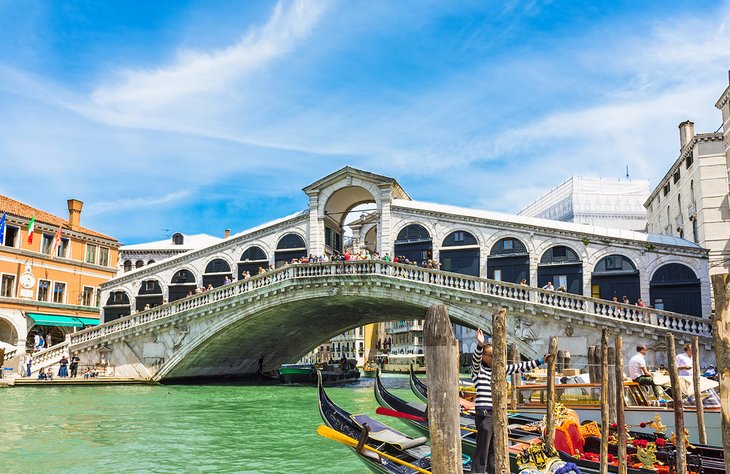
Rialto Bridge
Once the solely bridge throughout the Grand Canal, Rialto Bridge marks the spot of the island’s first settlement, referred to as Rivus Altus (high bank). Built in 1588, some one hundred fifty years after the cave in of a preceding wood bridge, this stone arch helps two busy streets and a double set of shops.
Along with serving as a busy crossing factor halfway alongside the canal, it is a favored vantage factor for travelers taking – or posing for – photos, and for looking at the assortment of boats usually passing beneath it.
The church of San Bartolomeo, shut to the San Marco stop of the bridge, used to be the church of the German retailers who lived and labored in the Fondaco dei Tedeschi (German Commodity Exchange) bordering the canal here. It has an high-quality altarpiece, The Martyrdom of St. Bartholomew, via Palma the Younger. The former alternate is now a famous vicinity to go shopping.
On the different facet of Rialto Bridge is the busy meals market, the place Venetians and cooks save for clean produce and seafood. In the slim streets of San Polo, past the market, are artisans’ retail outlets and mask-making studios, one of the nice locations for purchasing in Venice. You’ll additionally discover locations to consume that are no longer so stuffed with vacationers as these nearer San Marco.
- Torre dell’Orologio (Clock Tower)
Torre dell’Orologio (Clock Tower)
Torre dell’Orologio (Clock Tower)
To one facet of the basilica, dealin
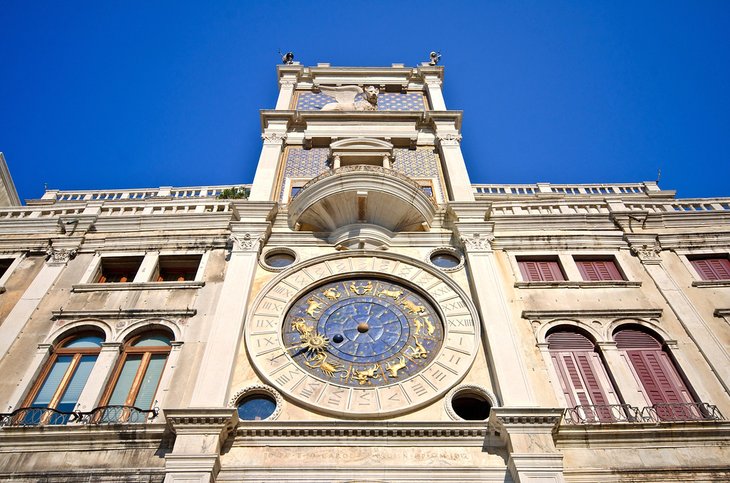
g with onto Piazza San Marco, is one of Venice’s most acquainted icons, a clock tower surmounted with the aid of a pair of bronze Moors that strike the giant bell every hour. The face of the clock suggests phases of the moon and the zodiac in gilt on a blue background, and above the clock is a small balcony and a statue of the Virgin.
Above that, the winged Lion of St. Mark and mosaic of gold stars towards a blue history had been brought in 1755 with the aid of Giorgio Massari. The tower itself is from the fifteenth century and traditional of Venetian Renaissance architecture. Through an arched gateway at its base runs one of Venice’s busiest streets, the slim Calle Mercerei.
If you are in Venice for the duration of Ascension Week or at Epiphany, as the Moors strike every hour, you can see the Three Kings led previous the Madonna by way of an angel. You can climb the tower for a nearer seem to be at the clockwork.
- Campanile
The Campanile on St. Mark’s Square
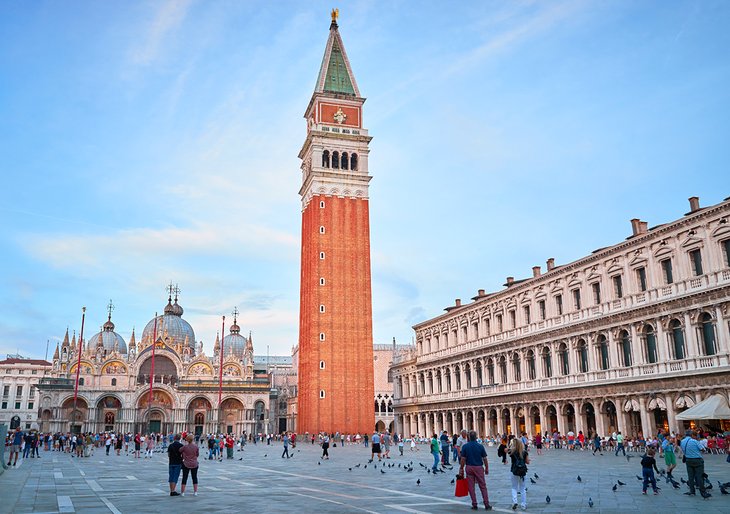
The Campanile on St. Mark’s Square
Standing like a large exclamation factor above the expanse of Piazza San Marco, the Campanile is no longer the first to stand here. The authentic one, erected as a lighthouse in 1153, collapsed dramatically into the piazza in 1902, and was once rebuilt on a less assailable footing. Also rebuilt was once the Loggetta at its base, a small marble loggia executed in 1540, the place individuals of the Great Council assembled earlier than assembly in the sessions.
In the loggia at the base, you can see Sansovino’s 4 bronze masterpieces between the columns, all of which have been rescued from the rubble after the collapse. The Campanile has a grimmer facet to its history: in the Middle Ages, prisoners, such as renegade priests, have been hoisted midway up the outdoor in cages, the place they hung suspended for weeks.
Today, the Campanile is a popular appeal for the views from the platform on top, which lengthen throughout the metropolis and lagoon to the Adriatic (try to go early or late in the day, as strains for the elevate can be very long).
- Santa Maria della Salute
Santa Maria della Salute
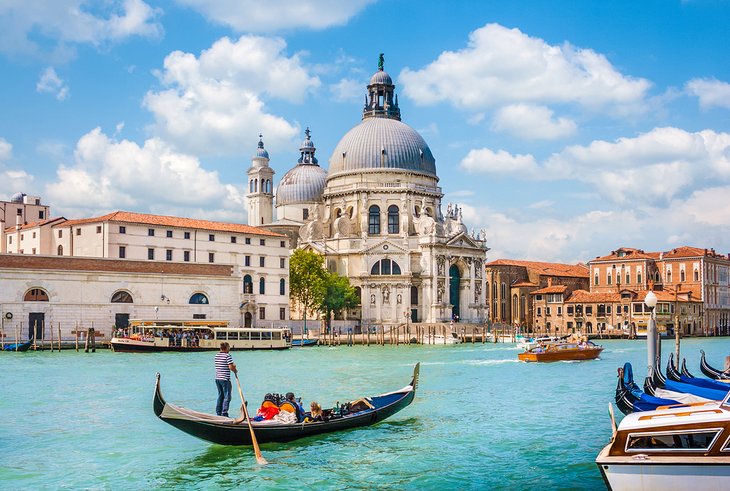
Santa Maria della Salute
One of the most photographed church buildings in Venice, Santa Maria della Salute has a postcard setting, rising at the tip of a peninsula throughout from the Doge’s Palace.
The huge Baroque church was once constructed as thanks for the stop of the plague of 1630. But the fragile land wouldn’t assist its extraordinary weight, so its architect, Baldassare Longhena, had extra than a million timbers pushed into the ground of the lagoon earlier than he ought to erect the church.
The vaporetto touchdown is proper in the front of the church, and the spotlight of its indoors – aside from the staggering dome – is the Sacristy, the place you may discover art work that encompass Tintoretto’s Marriage at Cana.
- Scuola Grande di San Rocco
Scuola Grande di San Rocco
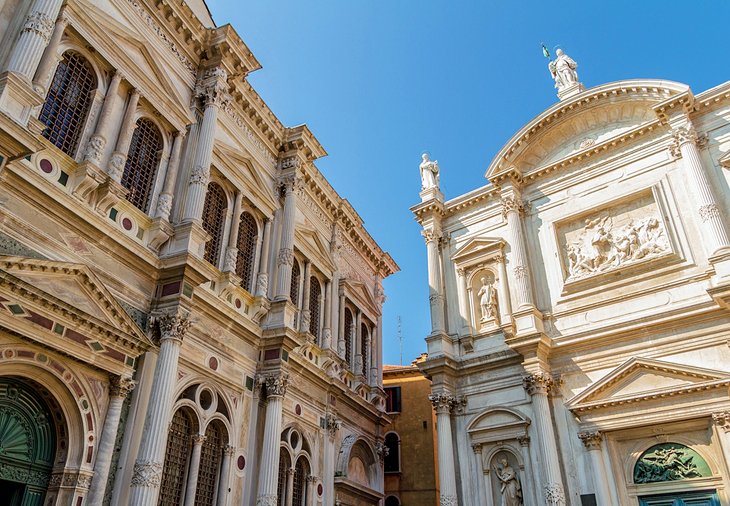
Scuola Grande di San Rocco
This spectacular white marble constructing was once constructed between 1515 and 1560 to residence a charitable society devoted to San Rocco. Soon after its completion, the remarkable 16th-century Venetian artist Tintoretto gained the opposition to paint a central panel for the ceiling of the Sala dell’Albergo via coming into the constructing and placing his portray in its meant region earlier than the judging, plenty to the infection of his rival artists.
He later embellished its partitions and ceilings with a entire cycle of paintings, which are viewed to be the artist’s masterpiece. The earliest works, in the Sala dell’Albergo, date to 1564 and 1576 and consist of The Glorification of St. Roch, Christ earlier than Pilate, the Ecce Homo, and the most effective of all, The Crucifixion. Those in the higher corridor depict New Testament scenes, painted between 1575 and 1581.
The lighting fixtures is now not good, and the artwork themselves are dark, however you can nevertheless recognize Tintoretto’s improvements in the use of mild and color. You can see the ceilings greater without difficulty with one of the mirrors that are provided. More works with the aid of Tintoretto are in the chancel of the adjoining church of San Rocco.
Address: Campo San Rocco, San Polo, Venice
- Teatro La Fenice
Teatro La Fenice
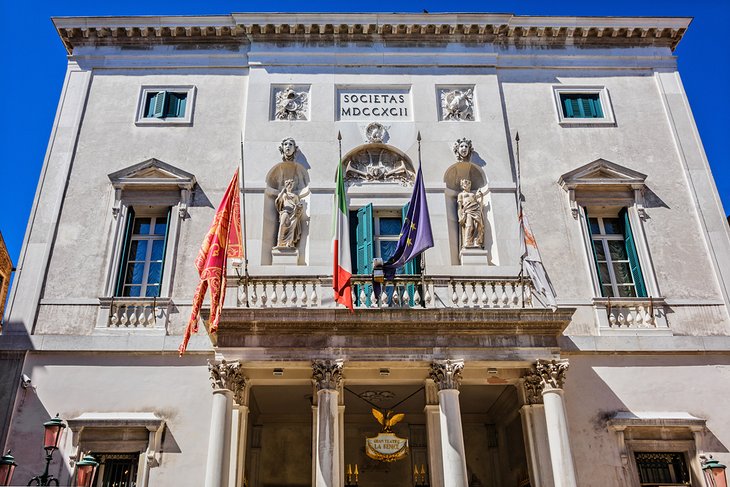
Teatro La Fenice
The identify La Fenice (The Phoenix), chosen at the constriction in 1792, proved prophetic, as like the legendary phoenix, it has risen from the ashes. The theater has been destroyed with the aid of hearth three times, the final one, in 1996, leaving solely the outer partitions standing. Each time, it has been rebuilt, and continues to be one of the world’s brilliant opera houses.
Throughout its history, however especially in the nineteenth century, La Fenice noticed the premiers of many of the most well-known Italian operas, such as these of Rossini, Donizetti, and Verdi, and these days schedules opera and ballet performances and musical concerts.
Even after its reopening in 2003 with particularly multiplied seating, La Fenice is nonetheless a comparatively small opera house, so tickets are very tough to get, specially for foremost performances. You can take a tour of the staggering Rococo interior, however, the use of an audio guide; these self-guided excursions closing about forty five minutes and encompass the public areas of the theater.
- Ca’ d’Oro
Ca’ d’Oro
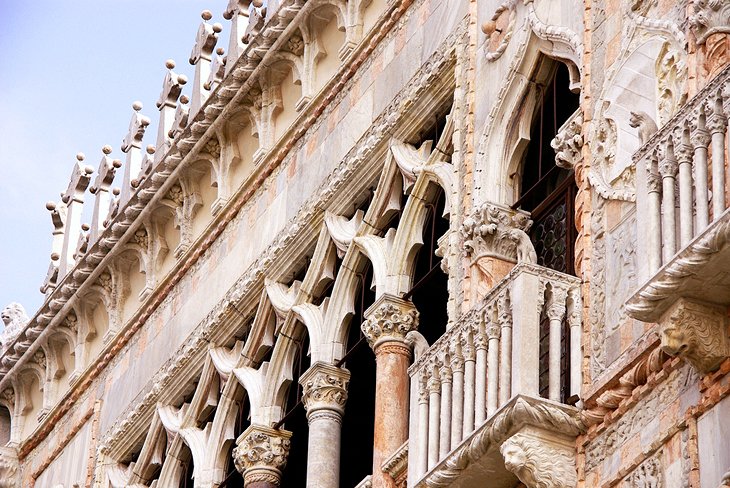
Ca’ d’Oro
The refined marble filigree by way of Bartolomeo Bon looks too lace-like to be carved of stone, and you can solely think about the influence this façade need to have made protected in its unique paint and gold. Along with the Porta della Carta in the Palazzo Ducale, additionally created with the aid of Bartolomeo Bon, this is regarded the most best instance of Venetian Gothic.
You can admire the interior, too, as this palazzo is now an artwork museum, restored to furnish each a placing for the artwork works and a appear at the way rich Venetians lived in the fifteenth and sixteenth centuries. The connoisseur accountable for saving the palace, Baron Giorgio Franchetti, gave his artwork series to the kingdom in 1922, with works through Titian, Mantegna, Van Dyck, Tullio Lombardo, and Bernini.
- Murano and Burano
Glassblowing in Murano
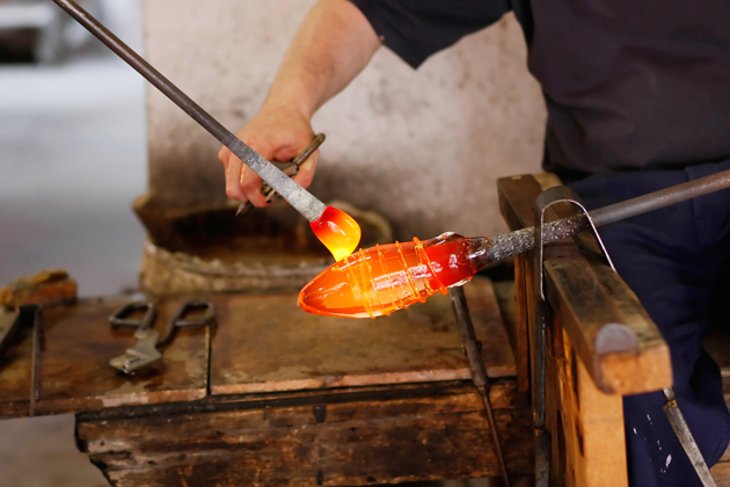
Glassblowing in Murano
A day trip to Venice would not be whole besides hopping aboard a vaporetto for the journey throughout the lagoon to Murano, domestic of Venice’s fabled glass workers. They have been despatched right here in the thirteenth century in hope of lowering the danger of fireplace from one of the glass furnaces sweeping via Venice’s tightly compacted center.
Or so they claimed. Just as likely, it was once to hold the secrets and techniques of glassblowing a Venetian monopoly. This was once no small remember to the Venetians, whose Council of Ten decreed in 1454: “If a glassblower takes his talent to some other u . s . a . to the detriment of the Republic he shall be ordered to return; ought to be refuse, his nearest household shall be thrown into jail so that his experience of household obligation may also set off him to return; must he persist in his disobedience secret measures shall be taken to put off him anywhere he might also be.” It was once a lot simpler to maintain tune of them if they had been constrained to an island.
The canal facets nowadays are lined by using glass showrooms and studios, displaying the whole thing from low cost imported trinkets to high-quality works of art. Inside the 17th-century Palazzo Giustinian is the Glass Museum, with one of the biggest and most vital collections of Venetian glass from the time of the Romans to the twentieth century.
But it is now not all glass: The church of Santi Maria e Donato combines Veneto-Byzantine and Early Romanesque features, a end result of its a number degrees of constructing between the seventh and twelfth centuries. Notice particularly the columns of Greek marble with Veneto-Byzantine capitals, the 12th-century mosaic ground with animal figures, and the St. Donato above the first altar on the left. Dated 1310, it is the earliest example of Venetian painting.
The 14th-century San Pietro Martire consists of quite a few terrific Venetian paintings: Bellini’s Madonna in Majesty with St. Mark and the Doge Agostino Barbarigo and his Assumption of the Virgin, alongside with St. Jerome in the Wilderness and St. Agatha in Prison with the aid of Paolo Veronese.
It’s a speedy hop to the subsequent island, Burano, a fishing village of brilliantly painted houses, regarded traditionally for its lace making. The Scuola dei Merletti (lace school) and its small museum will assist you distinguish the actual component from the low cost imports you may locate in most shops.
The narrow campanile of the 16th-century church of San Martino leans at an alarming angle, made all the greater dramatic by way of its height.
- Peggy Guggenheim Collection
Peggy Guggenheim Collection
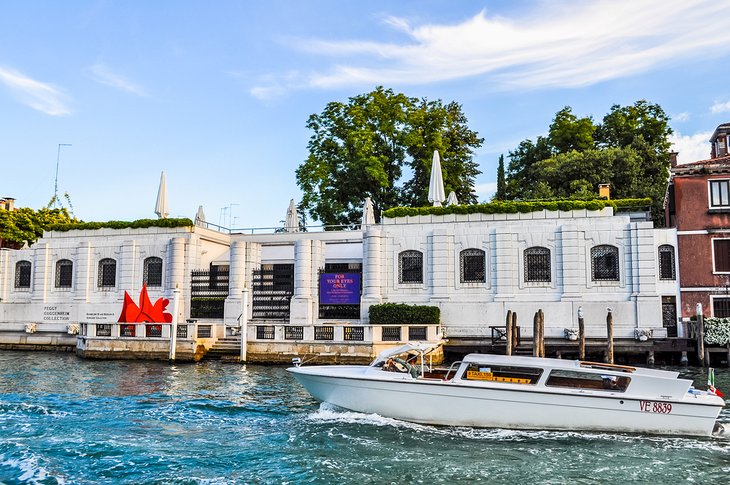
Peggy Guggenheim Collection | s74 / Shutterstock.com
The non-public artwork collections of heiress Peggy Guggenheim are housed in her former domestic alongside the Grand Canal, Palazzo Venier dei Leoni. Although most of Italy’s terrific artwork museums are stuffed with masters of the Middle Ages and Renaissance, this one concentrates on American and European artwork from the first 1/2 of the twentieth century.
The low building, with its spare, white interior, is a becoming venue for these daring and regularly dramatic works, which symbolize Cubist, Futurist, Abstract Expressionist, Surrealist, and avant-garde faculties of portray and sculpture.
The everlasting series consists of works with the aid of Picasso, Dali, Braque, Léger, Mondrian, Kandinsky, Klee, Ernst, Magritte, and Pollock, and standard exhibitions deliver in works from different most important artists. In the museum’s sculpture gardens are works by way of Calder, Holzer, Caro, Judd, and Hepworth.
Address: 704 Dorsoduro, Venice
Official site: http://www.guggenheim-venice.it
- Explore the Ghetto and Museo Ebraico di Venezia
Jewish Ghetto in Venice
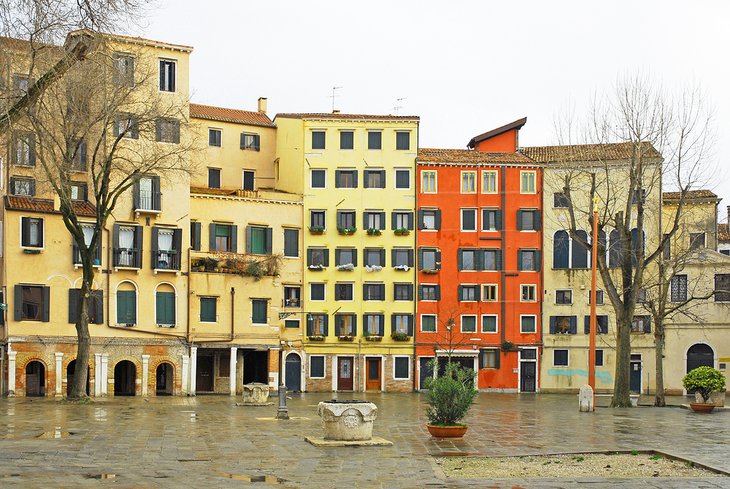
Jewish Ghetto in Venice
The Venetians referred to as the foundry right here geto, and in 1516 it used to be decreed that all Jews in the town would stay on this islet, the starting place of the phrase “ghetto.” Residents should solely go away in the daytime, and the gates had been locked and guarded at night.
This phase of the Cannaregio sestiere nevertheless has awesome Jewish presence, with synagogues and the Museo Ebraico di Venezia (Jewish Museum) with artifacts of Jewish lifestyles right here from the seventeenth and later centuries. Facing the Ghetto Nuovo Square, a touching memorial of bronze panels, created in 1980 by way of artist Arbit Blatas, remembers the victims of the deportation throughout the Nazi occupation of the town in 1943.
Address: Museo Ebraico di Venezia, Campo del Ghetto Nuovo, Cannaregio
- Santa Maria Gloriosa dei Frari
Santa Maria Gloriosa dei Frari
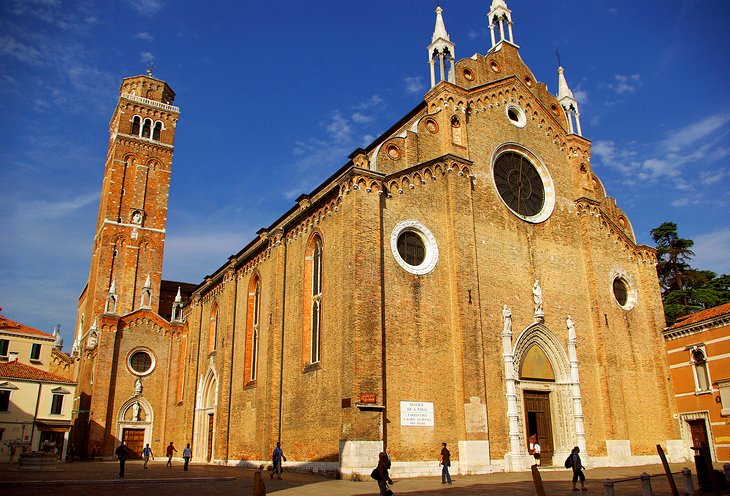
Santa Maria Gloriosa dei Frari
This Gothic church used to be begun via the Franciscans about 1340 and completed with the completion of the facade, interior, and two chapels in the center of the fifteenth century. Its dazzling 14th-century campanile is the 2d best possible in the city.
Although the indoors is in maintaining with the easy unadorned fashion of Franciscan churches, it carries a wealth of inventive treasures. In the proper transept is an necessary timber statue of St. John the Baptist by way of Florentine sculptor Donatello, carried out in 1451 (first chapel to the proper of the sanctuary).
In the vestry is a triptych Madonna and Child Enthroned with Four Saints with the aid of Giovanni Bellini. In the left transept, the statue of St. John the Baptist on the stoup of the Cappella Cornaro was once created by using the sculptor and master-builder Jacopo Sansovino
The Monks’ Choir is an great instance of the wood-carving of Marco Cozzi, with reliefs of saints and Venetian scenes. And the sanctuary includes the tomb of two Doges by way of Antonio Rizzo, and over the excessive altar is Titian’s Assunta, painted between 1516 and 1518. The Mausoleum of Titian in the south aisle was once a present from Ferdinand I of Austria, when he was once King of Lombardy Veneto.
You cannot assist noticing the pyramidal mausoleum made by using the college students of the sculptor Antonio Canova in the north aisle, and opposite, the massive monument to Titian, additionally by using college students of Canova. Beside the Cappella Emiliani, which has a fantastic mid-15th-century polyptych with marble figures, is Madonna di Ca’ Pesaro, finished in 1526 and one of Titian’s most vital works.
Address: Campo dei Frari, I-30100 Venice
Venice – Santa Maria Gloriosa dei Frari – Floor sketch map
Venice – Santa Maria Gloriosa dei Frari Map (Historical)
- Gallerie dell’Accademia (Fine Arts Museum)
Entrance to the Gallerie dell’Accademia (Fine Arts Museum)
Entrance to the Gallerie dell’Accademia (Fine Arts Museum)
Called “Accademia” for short, this museum on the Grand Ca
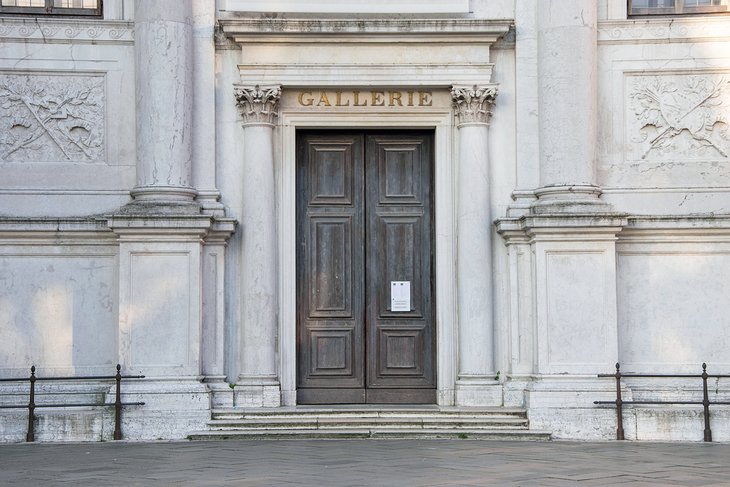
nal has the most essential and complete series of 15th-18th-century Venetian portray in existence. Much of the series used to be assembled from monasteries and church buildings that had been closed and from the clearing of palaces of noble families, now displayed in the former Monastery of Santa Maria della Carità.
Some of the galleries, such as the first one, which consists of Venetian Gothic Painting, have richly carved and gilded 15th-century ceilings. Works are organized chronologically, so you can no longer solely hint the evolution of styles, however can examine the works of contemporaries.
Highlights of the 15th- and 16th-century art work are St. George by using Andrea Mantegna, St Jerome and a Donor by means of Piero della Francesca, Madonna and Saints by way of Giovanni Bellini, Portrait of Christ through Vittore Carpaccio, and Madonna underneath the Orange Tree via Cima da Conegliano.
St. John the Baptist and a marvelous Pietà by means of Titian, Tintoretto’s Cain and Abel and The Miracle of St. Mark, Paolo Veronese’s Marriage of St. Catherine and Supper in the House of Levi, St. Ursula by way of Vittore Carpaccio, and numerous works by using Giambattista Tiepolo are additionally really worth exclusive notice.
Venice – Galleria dell’Accademia – Floor layout map
Venice – Galleria dell’Accademia Map (Historical)
- Santa Maria dei Miracoli
Santa Maria dei Miracoli
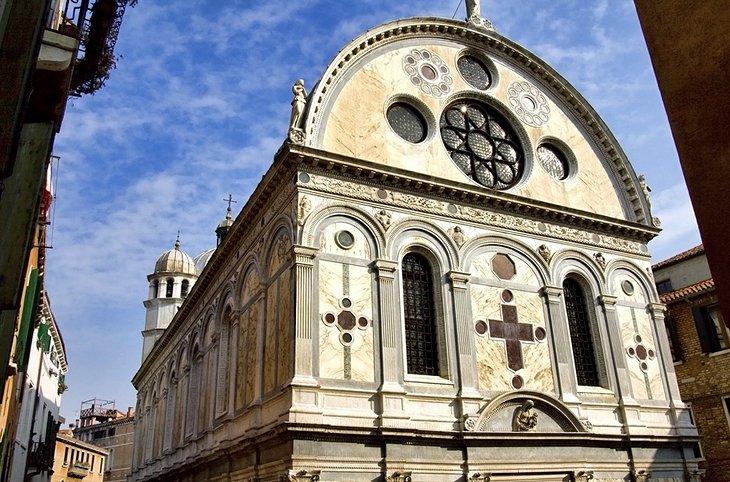
Santa Maria dei Miracoli
After the tremendous grandeur of St. Mark’s and the hovering expanse of Frari, little Santa Maria dei Miracoli is like a sparkling breeze, a masterpiece of Early Renaissance structure by using Pietro Lombardo. This jewel field of pastel inlaid marble was once constructed from 1481 to 1489 to enshrine a dazzling photo of the Virgin.
Unlike Venice’s different churches, whose facades are embellished with architectural prospers and statues, Lombardo used painstakingly matched coloured marble to create refined patterns of rosettes, circles, octagons, and crosses on the facade. The technique continues inside, which heightens the impact of the golden domed ceiling rising above grey and coral marble walls.
The nave is separated from the chancel with the aid of an splendid Early Renaissance balustrade adorned with figures. It’s no marvel that this is Venetians’ favourite area to be married, as its indoors is one of the most lovely in the city.
Address: Campo dei Miracoli, Venice
- Palazzo Rezzonico
Palazzo Rezzonico
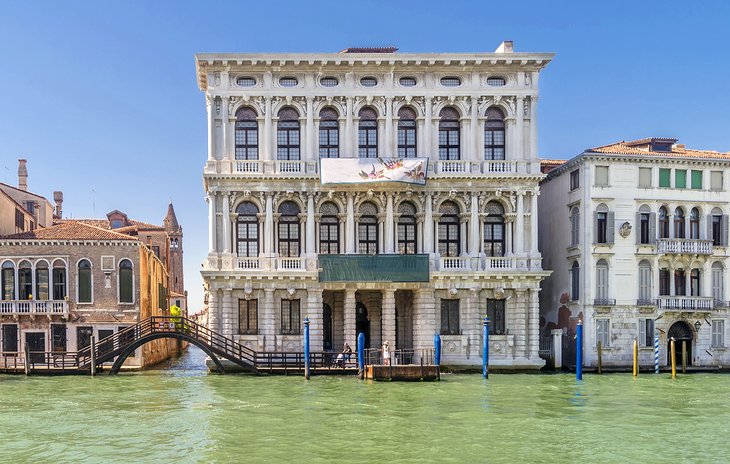
Palazzo Rezzonico
Just as Ca’ d’Oro lets you glimpse into the existence of the late Middle Ages, Palazzo Rezzonico offers a vivid photograph of existence right here in the Baroque and Rococo periods, in the 18th century. Designed and begun by means of Venice’s grasp of Baroque architecture, Baldassare Longhena, the palace used to be executed almost one hundred years later in 1750 through Giorgio Massari.
The furniture and collections entire the photograph painted via the building, along with its indoors ornament of silk wall coverings, based end details, and Flemish tapestries. The costume series highlights the significance of silk manufacturing in Venice from the late center a long time via the 18th century, when it was once a predominant competitor with Lyon, France.
Rigid technical policies have been enforced, ensuing in some of the most stunning silk fabric ever made. So vital was once silk that even in instances of combat with the Turks, fighting strains parted for the silk-laden ships to ignore through.
The museum small print the significance of luxurious goods, especially garb and fashion, for the Venetian financial system in the 18th century, when brocades embellished with gold and silver thread produced right here had been treasured at some point of Europe and the New World.
- Torcello Island
Torcello Island
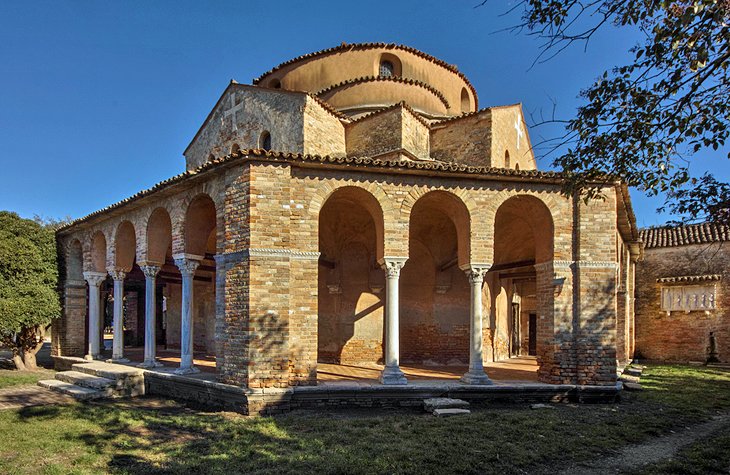
Torcello Island
Venice started out on this outer island of Torcello, centered right here as early as the seventh century, and through the twelfth century, it was once a flourishing industrial town. Of its palaces, churches, shipyards, and docks, solely two church buildings and a handful of homes remain, dotted over the giant island.
You can get some thought of the significance of Torcello from its cathedral, committed in 639 to Santa Maria Assunta. It is viewed the first-class final instance of Venetian-Byzantine architecture. It used to be reconstructed in 834 and 1008, and the portico and two lateral apses have been introduced in the ninth century; an awful lot of the constructing dates from the eleventh century. The mosaics lining the indoors are outstanding.
The oldest of these are in the chapel to the proper of the excessive altar, the place 11th-century angels carrying a medallion with the Lamb of God exhibit a robust Byzantine influence. The Fathers of the Church; Gregory, Martin, Ambrose, and Augustine; had been brought later, alongside with Christ in Majesty between two Archangels.
The 12th-century mosaics in the essential apse and the Virgin and Child above a frieze of the Twelve Apostles surrounded with the aid of plant life are all on a gold background. The west wall is included in tiers of a Byzantine mosaic of the Last Judgment from the late twelfth or early thirteenth century.
Along with the exquisitely distinctive marble carvings on the rood screen, word the 11th-century mosaic flooring and the pulpit, which was once assembled in the thirteenth century from previously fragments.
Adjoining the cathedral is the little 11th-century church of Santa Fosca, on a pure Byzantine central sketch with a portico. Your admission ticket consists of the fascinating little historic museum with artifacts from antiquity to sixteenth century.
- Lido
Alberoni Beach, Lido, Venice
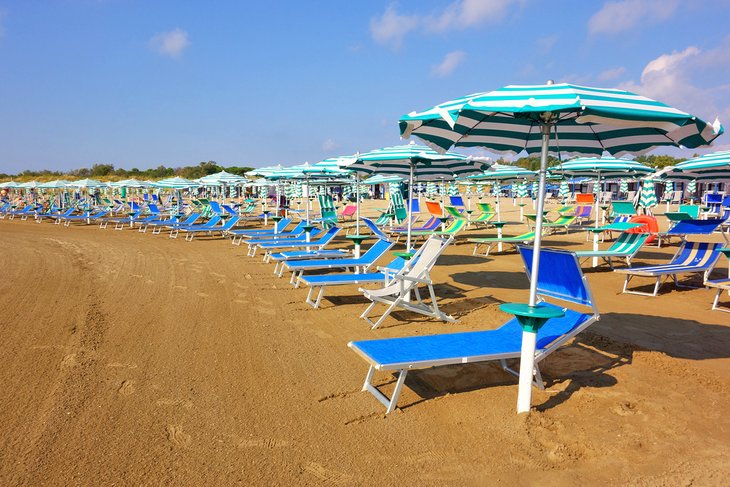
Alberoni Beach, Lido, Venice
The lengthy (12-kilometer) strip of sand that separates the Venetian lagoon from the Adriatic Sea was once Europe’s first actual seaside resort, and in its heyday, at the flip of the twentieth century, was once Europe’s most elegant watering gap for royalty and the day’s celebs. Today, the grand resorts the place they reposed nevertheless welcome company and nevertheless personal the lovely fine-sand beaches, though for a fee you can share them with resort guests.
Public seashores are at the north give up of the island, close to the church of San Nicolo, the place relics of St. Nicholas are revered. After giant controversy between Venice and Bari, which additionally claims the saint’s relics, it has been hooked up via an anatomical professional that each have an equal claim; about half of the skeleton, which includes the skull, is in Bari and the different half of in Lido. The cloisters are lovely, and in the church are art work by using each Palma the Elder and Younger.
You can tour Lido on foot or a bicycle rented close to the touchdown stage the place the 10-minute Motonave or longer vaporetto trip from St. Mark’s deposits you. The island is crammed with Art Nouveau villas and hotels; to see the villas, wander alongside some of the facet streets. In August and September, the Lido is the venue for the International Film Festival, held in the Palazzo del Cinema.
Lido Di Venezia map – Tourist attractions
Lido Di Venezia Map (Historical)
- Ca’ Pesaro and Galleria d’Arte Moderna
Galleria d’Arte Moderno and Museo d’Arte Orientale internal the Ca’ Pesaro
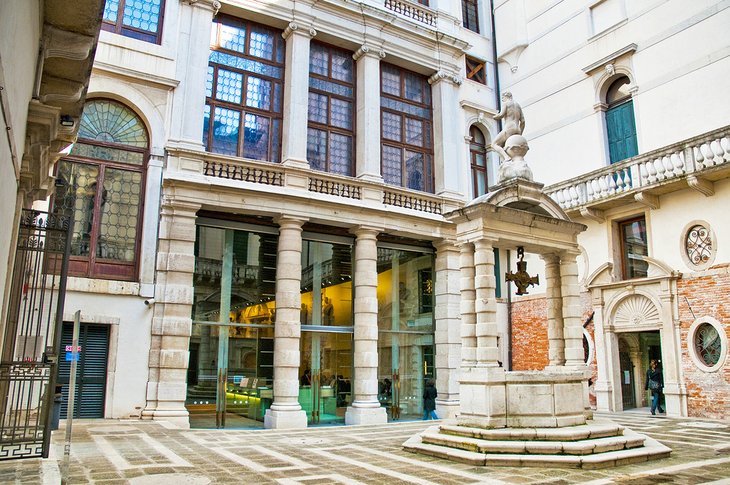
Galleria d’Arte Moderno and Museo d’Arte Orientale internal the Ca’ Pesaro
The awesome façade of Ca’ Pesaro overlooking the Grand Canal, used to be stimulated via the Sansovino Library that stands throughout from the Doge’s Palace, constructed a century earlier. The lavish Venetian Late Baroque indoors contrasts sharply with the artwork displayed there, for the palazzo now homes the Galleria d’Arte Moderna.
One of Italy’s greatest collections of contemporary art, it incorporates works by way of vital 19th- and 20th-century painters and sculptors which includes Gustav Klimt, Marc Chagall, and Auguste Rodin. Highlights encompass ornamental arts of the twentieth century such as works in glass made by means of Carlo Scarpa in the Nineteen Thirties and Nineteen Forties and uncommon fixtures portions with the aid of the cabinetmaker Carlo Bugatti.
The Museo d’Arte Orientale occupies the 1/3 ground of the palace, with collections of first-rate and utilized arts from Asia. Highlights are the Chinese vases and Japanese enamels, porcelains, and armor of the Edo period.
Ca’Pesaro is reached through Vaparetto from the San Stae stop, at the church of Sant’Eustachio, extra often recognised as San Stae. Step interior the church to see artwork by using early 18th-century artists, together with Tiepolo and Pellegrini.
Address: Santa Croce, Venice
- The Arsenal and the Museum of Naval History
The Arsenal and the Museum of Naval History
The Arsenal and the Museum of Naval History
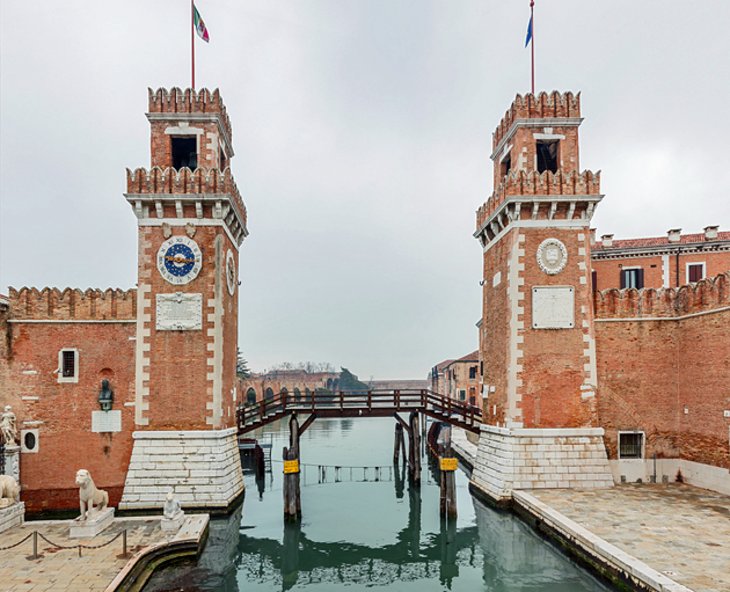
The Arsenal, the shipyard of the Venetian Repu
blic, was once the biggest and busiest in the world till the give up of the seventeenth century. From its founding in 1104, it was once consistently expanded, till in its heyday, it employed as many as 16,000 workers.
Closely guarded to keep the secret manufacturing techniques that enabled it to construct a utterly sea-ready ship in a single day, the Arsenal used to be reachable through one land and one sea strategy only. So tight used to be its protection that the Republic managed to preserve its artwork of shipbuilding secret till about 1550.
At its imposing land entrance is a Renaissance-style triumphal arch guarded through lions added from Greece as booty after the reconquest of the Peloponnese in the seventeenth century. Of the two lions on the left, the large one stood defend over the port of Piraeus, whilst its fellow stood on the avenue from Athens to Eleusis.
Adjacent to the shipyard is the Museum of Naval History, showing magnificent booty delivered lower back from the severa maritime wars of the Republic, alongside with captivating collections that consist of votive artwork made on wooden panels in thanks for rescues at sea. These charming pics are fascinating for their depiction of sea life, no longer so an awful lot for their creative finesse.
Models and artifacts relate to shipbuilding, the kinds of vessels afloat in the length that Venice used to be a sea power, and the Republic’s strongholds at some stage in the Adriatic. A massive mannequin of the legendary ship of nation Bucintoro, the Doge’s luxurious respectable galley, is specially interesting.
Address: Riva degli Schiavoni, Castello, Venice
